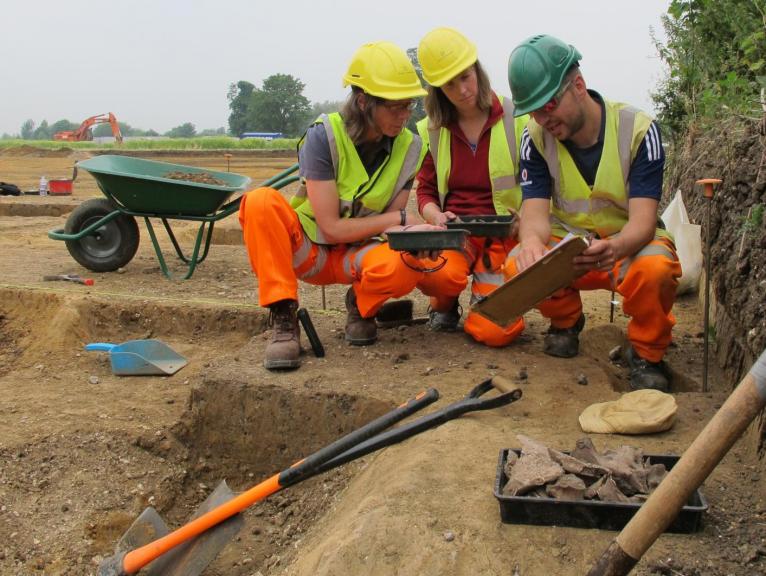Wessex Archaeology has teamed up with Butser Ancient Farm to help design and build a new Stone Age house on the site. In this blog series, we’re offering insights and updates about the build.
Our first blog is from Senior Project Manager, Gareth Chaffey, about the original excavations which brought about this experimental project.
Excavations at CEMEX Kingsmead Quarry, Horton, Berkshire, revealed unprecedented levels of early Neolithic domesticity in England.
Four structures were recorded over a four-year period (2008-2012) exposed occupation during the 38th and 37th centuries cal. BC, and evidence suggests that these were used as houses or dwellings for a small community or family group over several generations.
The discovery of the structures at Horton are of national importance. To date, few houses of this date have been found in England and rarely has more than one been found on a single site. The discoveries at Horton present the opportunity to enhance the knowledge and understanding of this period, to understand more about the earliest permanent settlements in prehistoric Britain and how such sites developed.
Neolithic houses at Horton
Two of the houses survived as no more than groups of postholes with a rectangular configuration, while the other pair had gully foundations which formed an external boundary, and both featured an internal partition dividing the structure into two rooms.
Radiocarbon dating has shown us that all the buildings were largely contemporary, possibly spanning around two or three generations. Interestingly the buildings of gully construction were seen to be marginally earlier.


Collaborating with Butser Ancient Farm
Butser Ancient Farm and Wessex Archaeology are working in collaboration to construct the largest of the houses, known as Horton 2. The building was discovered in 2012 and was extremely similar to Horton 1, found in 2008.
The reconstruction aims to recreate the structure using the archaeological evidence to guide the build and create a plausible version of what the house may have looked like.
Gareth Chaffey, Wessex Archaeology Project Manager who directed the excavations at the time, said:
“The collaboration with Butser has been fantastic for me. I found the house one morning back in 2012, and then watched the excavation unfold and directed that excavation, so for eight years later to be contacted by Butser Ancient Farm to say that they want to build the house that I found is very interesting.”

The archaeology of the Horton house
Horton 2 was chosen because it was the larger of the houses uncovered, measuring around 15m long and 7.5m wide.
The house had quite an irregular form; both its eastern and western ends bowed inwards slightly, and it tapered towards the eastern end. This led to the western edge measuring nearly 1m longer than the eastern edge.
The house appears to have been created around six dominant posts, a characteristic seen in all of the houses on the site and a very common pattern found in other houses of this period. The posts were located in each corner, as well as internally to create a partition which divided the space into two separate rooms.
The house construction appears to have been formed from vertical slit planks set into a foundation trench. These gullies were noticeably larger and deeper around the eastern room than the western room, which may suggest that a second storey or mezzanine level over this part of the structure. Shallower gullies on the western side of the structure may suggest lighter weight or less load bearing walls.
A technique called magnetic susceptibility analysis performed ahead of the excavation revealed a high reading of burnt material in the south-eastern corner of the house. When excavated, this area exposed a short, shallow segment of gully, suggesting a possible double entranceway for the building.
Each entrance was around 1m wide, whilst two external post-holes located immediately south of the entranceways may have acted as some form of screen or rudimentary porchway. No hearth material or floor surface was found, but for the burnt material identified in the gully through the magnetic susceptibility survey, suggesting that material was ‘swept’ from the house through its front door.
Once again, a largely domestic collection of artefacts was recovered from the structure. They included Plain Bowl pottery fragments, burnt flint, fired clay, flint working waster and several flint tools including a scraper and three leaf-shaped arrowheads. Two hammerstones were found in one of the post-holes, and a polishing/rubbing stone and a stone tool fragment were recovered from the house’s gully. Relatively small quantities of charred hazelnut shell fragments and cereal grain (hulled barley and free-threshing wheat), were also recovered.
What does this tell us about the Neolithic community that lived there?
The presence of the houses raises several questions about the population of the area that was building and using the structures. The discovery challenges our current understanding of how people lived more than 5,700 years ago, our concept of pioneer farmers introducing a new lifestyle into southern Britain, as well as suggesting long-distance contact and interaction.
We think that there were varying levels of temporality to the structures built at Horton. The act of building such structures in itself suggests a degree of long-term investment in a place. The artefacts recovered from the house appear to suggest a domestic function but, given its size, it may have acted as a hall or meeting place for a larger social group.
Radiocarbon dating on the structures gives us an idea of the sequencing of the buildings, and it appears that these were used and created over several generations. This period in history was one of environmental, landscape, settlement and economic change, with the domestication of plants and animals leading to more permanent settlements.
The act of reconstructing the building at Butser will undoubtedly affect our understanding of all four of the early Neolithic structures excavated at Horton. The rare opportunity to be involved with such research will be invaluable in our post-excavation works moving forwards.

